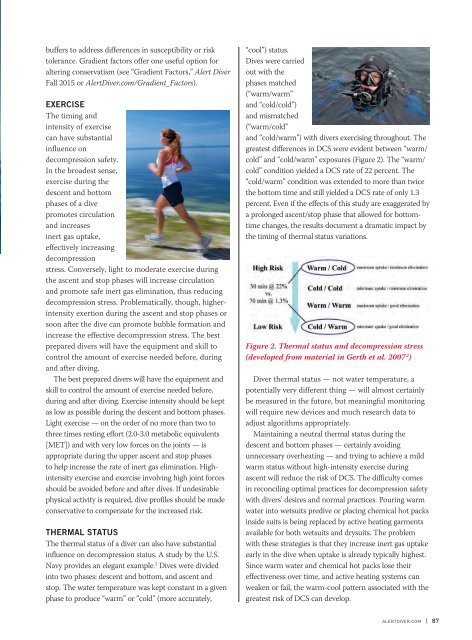AD 2016 Q4
Alert Diver is the dive industry’s leading publication. Featuring DAN’s core content of dive safety, research, education and medical information, each issue is a must-read reference, archived and shared by passionate scuba enthusiasts. In addition, Alert Diver showcases fascinating dive destinations and marine environmental topics through images from the world’s greatest underwater photographers and stories from the most experienced and eloquent dive journalists in the business.
Alert Diver is the dive industry’s leading publication. Featuring DAN’s core content of dive safety, research, education and medical information, each issue is a must-read reference, archived and shared by passionate scuba enthusiasts. In addition, Alert Diver showcases fascinating dive destinations and marine environmental topics through images from the world’s greatest underwater photographers and stories from the most experienced and eloquent dive journalists in the business.
Create successful ePaper yourself
Turn your PDF publications into a flip-book with our unique Google optimized e-Paper software.
uffers to address differences in susceptibility or risk<br />
tolerance. Gradient factors offer one useful option for<br />
altering conservatism (see “Gradient Factors,” Alert Diver<br />
Fall 2015 or AlertDiver.com/Gradient_Factors).<br />
EXERCISE<br />
The timing and<br />
intensity of exercise<br />
can have substantial<br />
influence on<br />
decompression safety.<br />
In the broadest sense,<br />
exercise during the<br />
descent and bottom<br />
phases of a dive<br />
promotes circulation<br />
and increases<br />
inert gas uptake,<br />
effectively increasing<br />
decompression<br />
stress. Conversely, light to moderate exercise during<br />
the ascent and stop phases will increase circulation<br />
and promote safe inert gas elimination, thus reducing<br />
decompression stress. Problematically, though, higherintensity<br />
exertion during the ascent and stop phases or<br />
soon after the dive can promote bubble formation and<br />
increase the effective decompression stress. The best<br />
prepared divers will have the equipment and skill to<br />
control the amount of exercise needed before, during<br />
and after diving.<br />
The best prepared divers will have the equipment and<br />
skill to control the amount of exercise needed before,<br />
during and after diving. Exercise intensity should be kept<br />
as low as possible during the descent and bottom phases.<br />
Light exercise — on the order of no more than two to<br />
three times resting effort (2.0-3.0 metabolic equivalents<br />
[MET]) and with very low forces on the joints — is<br />
appropriate during the upper ascent and stop phases<br />
to help increase the rate of inert gas elimination. Highintensity<br />
exercise and exercise involving high joint forces<br />
should be avoided before and after dives. If undesirable<br />
physical activity is required, dive profiles should be made<br />
conservative to compensate for the increased risk.<br />
THERMAL STATUS<br />
The thermal status of a diver can also have substantial<br />
influence on decompression status. A study by the U.S.<br />
Navy provides an elegant example. 2 Dives were divided<br />
into two phases: descent and bottom, and ascent and<br />
stop. The water temperature was kept constant in a given<br />
phase to produce “warm” or “cold” (more accurately,<br />
“cool”) status.<br />
Dives were carried<br />
out with the<br />
phases matched<br />
(“warm/warm”<br />
and “cold/cold”)<br />
and mismatched<br />
(“warm/cold”<br />
and “cold/warm”) with divers exercising throughout. The<br />
greatest differences in DCS were evident between “warm/<br />
cold” and “cold/warm” exposures (Figure 2). The “warm/<br />
cold” condition yielded a DCS rate of 22 percent. The<br />
“cold/warm” condition was extended to more than twice<br />
the bottom time and still yielded a DCS rate of only 1.3<br />
percent. Even if the effects of this study are exaggerated by<br />
a prolonged ascent/stop phase that allowed for bottomtime<br />
changes, the results document a dramatic impact by<br />
the timing of thermal status variations.<br />
Figure 2. Thermal status and decompression stress<br />
(developed from material in Gerth et al. 2007 2 )<br />
Diver thermal status — not water temperature, a<br />
potentially very different thing — will almost certainly<br />
be measured in the future, but meaningful monitoring<br />
will require new devices and much research data to<br />
adjust algorithms appropriately.<br />
Maintaining a neutral thermal status during the<br />
descent and bottom phases — certainly avoiding<br />
unnecessary overheating — and trying to achieve a mild<br />
warm status without high-intensity exercise during<br />
ascent will reduce the risk of DCS. The difficulty comes<br />
in reconciling optimal practices for decompression safety<br />
with divers’ desires and normal practices. Pouring warm<br />
water into wetsuits predive or placing chemical hot packs<br />
inside suits is being replaced by active heating garments<br />
available for both wetsuits and drysuits. The problem<br />
with these strategies is that they increase inert gas uptake<br />
early in the dive when uptake is already typically highest.<br />
Since warm water and chemical hot packs lose their<br />
effectiveness over time, and active heating systems can<br />
weaken or fail, the warm-cool pattern associated with the<br />
greatest risk of DCS can develop.<br />
ALERTDIVER.COM | 87










